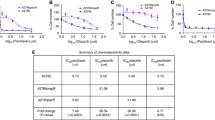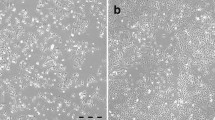Abstract
Etoposide (VP-16) is one of the most important anticancer agents available and is used in many chemotherapeutic regimens. To characterize resistance to this drug, we established a VP-16-resistant human ovarian cancer cell line, SKOV3/VP, by continuous stepwise exposure of SKOV3 cells to VP-16. The degree of resistance to VP-16 of SKOV3/VP was about 25 times that of the parent cell line (SKOV3), and SKOV3/VP showed crossresistance to teniposide, adriamycin, CPT-11, and vincristine. The accumulation of [3H]-VP-16 observed in SKOV3/VP cells was about half that seen in SKOV3 cells, and the accumulation of Adriamycin by this resistant cell line was also lower than that of its parent. Overexpression of neither the multidrug resistance genemdr-1, the multidrug-resistance-associated protein (mrp) gene, nor P-glycoprotein was detected using reverse transcriptase-polymerase chain reaction analysis and flow cytometry with MRK-16, a monoclonal antibody against P-glycoprotein. The topoisomerase II activity of nuclear extracts from SKOV3/VP cells was lower than that from the parental cells, as was the amount of DNA topoisomerase II, demonstrated by immunoblotting. These results suggest that the mechanism responsible for the multidrug resistance of this cell line may be attributable to changes on its DNA topoisomerase II and to its reduced accumulation of the drugs as compared with the parental line SKOV3.
Similar content being viewed by others
References
Beck WT, Cirtain MC, Danks MK (1987) Pharmacological, molecular, and cytogenetic analysis of “atypical” multidrug-resistant human leukemic cells. Cancer Res 47: 5455–5460
Chen GL, Yang L, Rowe TC (1984) Nonintercalative antitumor drugs interfere with the breakage-reunion reaction of mammalian DNA topoisomerase II. J Biol Chem 259: 13560–13566
Chomczynski P, Sacchi N (1987) Single-step method of RNA isolation by acid guanidinium thiocyanate-phenol-chloroform extraction. Anal Biochem 162: 156–159
Cole SPC (1992) Drug resistance and lung cancer. In: Wood J (ed) Cancer: concept to clinic. Medical Publishing Enterprises, Fairlawn, New Jersey
Cole SPC, Bhardwaj G, Gerlach JH (1992) Overexpression of a transporter gene in a multidrug-resistant human lung cancer cell line. Science 258: 1650–1654
Danks MK, Yalowich JC, Beck WT (1987) Atypical multiple drug resistance in a human leukemic cell line selected for resistance to teniposide (VM-26). Cancer Res 47: 1297–1301
Deffie AM, Batra JK, Goldenberg GJ (1989) Direct correlation between DNA topoisomerase II activity and cytotoxicity in Adriamycin-sensitive and-resistant P388 leukemia cell lines. Cancer Res 49: 58–60
Ferguson PJ, Cheng YC (1987) Transient protection of cultured human cells against antitumor agents by 1,2-0-tetradecanoylphorbol 1,3-acetate. Cancer Res 47: 433–441
Ferguson PJ, Fisher MH, Stephenson J (1988) Combined modalities of resistance in etoposide-resistant human KB cell lines. Cancer Res 48: 5956–5964
Hill BT, Lock RB (1989) Tumor cell resistance to etoposide (VP-16)—review. In: Kessel D (ed) Resistance to antineoplastic drugs. CRC Press, Boca Raton, Florida, p 185
Hill BT, Whelan RD, Hosking LK (1988) Interactions between antitumor drugs and radiation in mammalian tumor cell lines: differential drug responses and mechanisms of resistance following fractionated X-irradiation or continuous drug exposure in vitro. NCI Monogr 6: 177–182
Horichi N, Tapiero H, Sugimoto Y (1990) 3-Deamino-3-morpholino-13-deoxo-10-hydroxycarminomycin conquers multidrug resistance by rapid influx following higher frequency of formation of DNA single- and double-strand breaks. Cancer Res 50: 4698–4701
Kanzawa F, Sugimoto Y, Kasahara K (1990) Establishment of a camptothecin analog (CPT-11)-resistant cell line of human nonsmall cell lung cancer: characterization and mechanism of resistance. Cancer Res 50: 5919–5924
Kasahara K, Fujiwara Y, Sugimoto Y (1992) Determinants of response to the DNA topoisomerase II inhibitors doxorubicin and etoposide in a human lung cancer cell line. J Natl Cancer Inst 84: 113–118
Kinoshita T, Imamura J, Nagai H (1992) Quantification of gene expression over a wide range by the polymerase chain reaction. Anal Biochem 206: 231–235
Kubota N, Kanzawa F, Nishio K (1992) Detection of topoisomerase I gene point mutation in a CPT-11 resistant lung cancer cell line. Biochem Biophys Res Commun 188: 571–577
Long BH, Musial ST, Brattain MG (1986) DNA breakage in human lung carcinoma cells and nuclei that are naturally sensitive or resistant to etoposide and teniposide. Cancer Res 46: 3809–3816
Minato K, Kanzawa F, Nishio K (1990) Characterization of an etoposide-resistant human small-cell lung cancer cell line. Cancer Chemother Pharmacol 26: 313–317
Minford J, Pommier Y, Filipski J (1986) Isolation of intercalator-dependent protein-linked DNA strand cleavage activity from cell nuclei and identification as topoisomerase II. Biochemistry 25: 9–16
Mosmann T (1983) Rapid colorimetric assay for cellular growth and survival: application of proliferation and cytotoxicity assays. J Immunol Methods 65: 55–63
Noonan KE, Beck C, Holzmayer TA (1990) Quantitative analysis of MDR1 (multidrug resistance) gene expression in human tumors by polymerase chain reaction. Proc Natl Acad Sci USA 87: 7160–7164
Rowe T, Kupfer G, Ross W (1985) Inhibition of epipodophyllotoxin cytotoxicity by interference with topoisomerase-mediated DNA cleavage. Biochem Pharmacol 34: 2483–2487
Slovak ML, Ho JP, Bhardwaj G (1993) Localization of a novel multidrug resistance-associated, gene in the HT1080/DR4 and H69AR human tumor cell lines. Cancer Res 53: 3221–3225
Takeda Y, Nishio K, Sugimoto Y (1991) Establishment of a human leukemia subline resistant to the growth-inhibitory effect of 12-o-tetradecanoylphorbol 13-acetate (TPA) and showing non-P-glycoprotein-mediated multi-drug resistance. Int J Cancer 48: 931–937
Tsuruo T, Iida-Saito H, Kawabata H (1986) Characteristics of resistance to Adriamycin in human myelogenous leukemia K562 resistant to Adriamycin and in isolated clones. Jpn J Cancer Res 77: 682–692
Zaman GJR, Versantvoort CHM, Smit JJM (1993) Analysis of the expression of MRP, the gene for a new putative transmembrane drug transporter, in human multidrug resistant lung cancer cell lines. Cancer Res 53: 1747–1750
Author information
Authors and Affiliations
Rights and permissions
About this article
Cite this article
Kubota, N., Nishio, K., Takeda, Y. et al. Characterization of an etoposide-resistant human ovarian cancer cell line. Cancer Chemother. Pharmacol. 34, 183–190 (1994). https://doi.org/10.1007/BF00685075
Received:
Accepted:
Issue Date:
DOI: https://doi.org/10.1007/BF00685075




